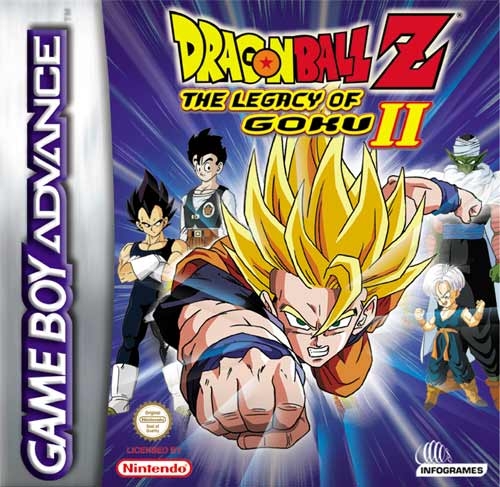Dragon Ball Z The Legacy Of Goku Ii Gba
- Dbz Legacy Of Goku Rom
- Dragon Ball Z The Legacy Of Goku 2 Gba
- Dragon Ball Z The Legacy Of Goku 2 Gba Rom Download
- Dragon Ball Z Legacy 2
Game Boy Advance Game (GBA)
Jun 18, 2003 Dragon Ball Z: The Legacy of Goku II builds upon the brand and design established in last year's original, but the development team improved almost every aspect of the first game in the series.
Dbz Legacy Of Goku Rom
Game Rating
Fight like a super Saiyan in this cool action packed anime fighting game for the Game Boy Advance. Experience various portions of the franchise in Dragon Ball Z: The Legacy of Goku! The game is a cool fighting game based on the very popular anime TV series Dragon Ball Z. Legacy of Goku was one of the three action game of the series, and is the first one of the three.
In this game, the player must take control of a Dragon Ball Z character (DBZ), and take a part and experience various portions of the anime. The game focuses in fast--paced combat with two attack modes: Melee attack and energy strikes. By defeating enemies, the player receives experience points, which allow the player character to level up and grow stronger.

Emulator Controls
←→↑↓ = Directions
Z = A X = B
Dragon Ball Z The Legacy Of Goku 2 Gba
A = L S = R
enter ↵ = Start
← backspace = Select
Related Games
Dragon Ball Z The Legacy Of Goku 2 Gba Rom Download
Dragon Ball Z: The Legacy of Goku is an online GBA game that you can play at Emulator Online. This free Game Boy Advance game is the United States of America region version for the USA. Dragon Ball Z: The Legacy of Goku is a single title from the many manga games, adventure games and rpg games offered for this console. If you enjoyed playing this, then you can find similar games in the gba games category. Dragon Ball Z: The Legacy of Goku game is from the various retro games on the site, and there are more games like this, including Spyro the Dragon, Dragon Ball Z - Buu’s Fury and Dragon Ball Z: Hyper Dimension.
Dragon Ball Z Legacy 2
Download 2288 – 2 in 1 – Dragon Ball Z – The Legacy of Goku I & II (U) GBA ROM
The Game Boy Advance[a] (GBA) is a 32-bit handheld video game console developed, manufactured and marketed by Nintendo as the successor to the Game Boy Color. It was released in Japan on March 21, 2001, in North America on June 11, 2001, in Australia and Europe on June 22, 2001, and in mainland China on June 8, 2004 as iQue Game Boy Advance. The GBA was part of the sixth generation. The original model was not backlit and Nintendo addressed that with the release of the redesigned Game Boy Advance SP in 2003. Another redesign, the Game Boy Micro, was released in 2005.
As of June 30, 2010, the Game Boy Advance series has sold 81.51 million units worldwide. Its successor, the Nintendo DS, was released in November 2004 and is also compatible with Game Boy Advance software.
Contrary to the previous Game Boy models, which were all following the “portrait” form factor of the original Game Boy (designed by Gunpei Yokoi), the Game Boy Advance was designed in a “landscape” form factor, putting the buttons to the sides of the device instead of below the screen. The Game Boy Advance was designed by the French designer Gwénaël Nicolas and his Tokyo-based design studio Curiosity Inc.
Word of a successor to the Game Boy Color (GBC) first emerged at the Nintendo Space World trade show in late August, 1999, where it was reported that two new handheld systems were in the works: an improved version of the GBC with wireless online connectivity, codenamed the Advanced Game Boy (AGB), and a brand-new 32-bit system, which wasn’t set for release until the following year. On September 1st, 1999, Nintendo officially announced the Game Boy Advance, revealing details about the system’s specifications including online connectivity through a cellular device and an improved model of the Game Boy Camera. Nintendo teased that the handheld would first be released in Japan in August of 2000, with the North American and European launch dates slated for the end of the same year. Simultaneously, Nintendo announced a partnership with Konami to form Mobile 21, a development studio that would focus on creating technology for the GBA to interact with the Dolphin, Nintendo’s home console which was also in development at the time. On August 21, 2000, IGN showed off images of a GBA development kit running a demonstrational port of Yoshi Story, and on August 22nd, pre-production images of the GBA were revealed in an issue of Famitsu magazine in Japan. On August 24th, Nintendo officially revealed the console to the public in a presentation, revealing the Japanese and North American launch dates, in addition to revealing that 10 games would be available as launch titles for the system.
The GBA was then featured at Nintendo Space World 2000 from August 24-26 alongside several peripherals for the system, including the GBA Link cable, the GameCube – Game Boy Advance link cable, a rechargable battery pack for the system, and an infrared communications adaptor which would allow systems to exchange data with each other. In March of 2001, Nintendo revealed details about the system’s North American launch, including the suggested price of $99.99 and the 15 launch games. Nintendo estimated that around 60 games would be made available for the system by the end of 2001